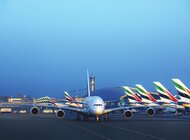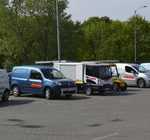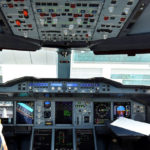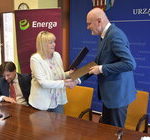Data publikacji: 11.05.2017 Oryginalny tytuł wiadomości prasowej: Grupa Emirates ogłasza wyniki za rok podatkowy 2016-17 Kategoria: transport, ekonomia/biznes/finanse
Grupa
Grupa odnotowuje zyski 29. rok z rzędu, tym roku w wysokości 2,5 mld AED (670 mln USD)
Stabilny rozwój działalności w miarę wzrostu zdolności przewozowej dowodzi odporności biznesowej Grupy na bardzo konkurencyjny rynek w burzliwym roku
Grupa podjęła znaczące inwestycje na poziomie 13,7 mld AED (3,7 mld USD) w rozwój swojej działalności
Emirates odnotowuje zysk na poziomie 1,3 mld AED (340 mln USD)
Oferowanie linii przekracza poziom 60 mld tonokilometrów (ATKM) dzięki dostawie 35 nowych samolotów (przy jednoczesnym wycofaniu z floty 27 starszych modeli)
Stabilny przychód na poziomie 85,1 mld AED (23,2 mld USD) po stracie 2,1 mld AED (572 mld USD) w wyniku niekorzystnego kursu walutowego
dnata odnotowała rekordowy zysk na poziomie 1,2 mld AED (330 mln USD)
Rekordowy przychód na poziomie 12,2 mld AED (3,3 mld USD) odzwierciedla dalszy rozwój spółki (ponad 66% przychodu pochodzi z działalności międzynarodowej)
Spółka powiększa swój globalny zasięg dzięki przejęciom w obu Amerykach, zyskując w ten sposób nowe ośrodki oraz możliwości w takich obszarach, jak obsługa lotnisk, cargo, catering oraz usługi turystyczne
Czwartek, 11 maja 2017 r. – DUBAJ, ZEA – Grupa Emirates poinformowała, że 29. rok z rzędu odnotowała zysk i stabilny rozwój firmy, mimo trudnego roku dla lotnictwa oraz sektora turystycznego.
W opublikowanym dziś raporcie rocznym, Grupa Emirates ogłosiła zysk w wysokości 2,5 mld AED (670 milionów USD) za rok finansowy kończący się 31 marca 2017 r., czyli o 70% niższy w stosunku do zeszłorocznego zysku rekordowego. Przychody Grupy wyniosły 94,7 mld AED (25,8 mld USD), co stanowi wzrost o 2% w stosunku do zeszłorocznych wyników, a saldo środków pieniężnych Grupy zmniejszyło się o 19% do 19,1 mld AED (5,2 mld USD), głównie w wyniku spłaty dwóch obligacji z terminem zapadalności i wysokich inwestycji w flotę i zasoby związane z samolotami.
Zgodnie z obecnym stanem koniunktury i wspieraniem przyszłych planów inwestycyjnych Grupy, za rok fiskalny 2016-17 nie będzie wypłacana dywidenda na rzecz Investment Corporation of Dubai (ICD).
W latach 2016-17 Grupa zainwestowała łącznie 13,7 mld AED (3,7 mld USD) w nowe maszyny i urządzenia, przejęcia innych firm, nowoczesne udogodnienia, najnowsze technologie i inicjatywy na rzecz pracowników.
Pełne sprawozdanie roczne za 2016-17 Grupy Emirates, obejmującej linie Emirates, dnata i ich spółki zależne, jest dostępne pod adresem: www.theemiratesgroup.com/annualreport
1 / 2
Kwoty w USD są przeliczane wg. kursu 1 USD = 3,67 AED i są oparte na pełnych liczbach AED przed zaokrągleniem.
* * *
Pełna treść komunikatu po angielsku
Emirates Group Announces 2016-17 results
Group records 29th consecutive year of profit of AED 2.5 billion (US$ 670 million)
Steady business growth in line with capacity increases, results show business resilience in a competitive climate and turbulent year
Significant investment in the business at AED 13.7 billion (US$ 3.7 billion)
Emirates reports a profit of AED 1.3 billion (US$ 340 million)
Airline capacity crosses 60 billion ATKM. 35 new aircraft delivered, and 27 older aircraft retired during the year
Stable revenue at AED 85.1 billion (US$ 23.2 billion), after a AED 2.1 billion (US$ 572 million) hit due to unfavourable currency exchange
dnata makes highest profit ever, at AED 1.2 billion (US$ 330 million)
Record revenue of AED 12.2 billion (US$ 3.3 billion) reflects further business expansion, with international business now accounting for 66% of revenue
Expands global footprint with ground handling acquisitions in the Americas, adds new facilities and service capabilities across its airport, cargo, catering, and travel services divisions
DUBAI, UAE, 11 May 2017 – The Emirates Group today announced its 29th consecutive year of profit and steady business expansion, despite a turbulent year for aviation and travel.
Released today in its 2016-17 Annual Report, the Emirates Group posted an AED 2.5 billion (US$ 670 million) profit for the financial year ending 31 March 2017, down 70% from last year’s record profit. The Group’s revenue reached AED 94.7 billion (US$ 25.8 billion), an increase of 2% over last year’s results, and the Group’s cash balance decreased by 19% to AED 19.1 billion (US$ 5.2 billion) mainly due to the repayment of two bonds on maturity and ongoing high investments into its fleet and aircraft related assets.
In line with the current business climate and to support the future investment plans of the Group, no dividend payment will be made to the Investment Corporation of Dubai (ICD) for 2016-17.
His Highness (H.H.) Sheikh Ahmed bin Saeed Al Maktoum, Chairman and Chief Executive, Emirates Airline and Group, said: “Emirates and dnata have continued to deliver profits and grow the business, despite 2016-17 having been one of our most challenging years to date.
“Over the years, we have invested to build our business capabilities and brand reputation. We now reap the benefits as these strong foundations have helped us to weather the destabilising events which have impacted travel demand during the year – from the Brexit vote to Europe’s immigration challenges and terror attacks, from the new policies impacting air travel into the US, to currency devaluation and funds repatriation issues in parts of Africa, and the continued knock-on effect of a sluggish oil and gas industry on business confidence and travel demand.”
In 2016-17, the Group collectively invested AED 13.7 billion (US$ 3.7 billion) in new aircraft and equipment, the acquisition of companies, modern facilities, the latest technologies, and staff initiatives.
Sheikh Ahmed said: “These investments will further strengthen our resilience, even as we extend our competitive edge, and adapt our businesses to the volatile business climate and fast changing consumer expectations.
“We remain optimistic for the future of our industry, although we expect the year ahead to remain challenging with hyper competition squeezing airline yields, and volatility in many markets impacting travel flows and demand.
“Emirates and dnata will stay attuned to the events and trends that impact our business, so that we can respond quickly to opportunities and challenges. We will also progress on our digital transformation journey. We are redesigning every aspect of how we do business, powered by an entirely new suite of technologies. Our aim is to deliver more personalised customer experiences, and seamless customer journeys, and make our operations and back-office functions even more efficient.”
Across its more than 80 subsidiaries and companies, the Group increased its total workforce by 11% to over 105,000-strong, representing over 160 different nationalities.
Emirates performance
Emirates’ total passenger and cargo capacity crossed the 60 billion mark, to 60.5 billion ATKMs at the end of 2016-17, cementing its position as the world’s largest international carrier. The airline increased capacity during the year by 4.1 billion Available Tonne Kilometres (ATKMs), or 7% over 2015-16.
Emirates received 35 new aircraft, its highest number during a financial year, comprising of 19 A380s and 16 Boeing 777-300ERs. At the same time 27 older aircraft were phased out, bringing its total fleet count to 259 at the end of March. This fleet roll-over involving 62 aircraft was the largest programme it has ever managed in a year, and it brought Emirates’ average fleet age down significantly to 63 months, compared with 74 months last year, and the industry average of 140 months.
It underscores Emirates’ strategy to operate a young and modern fleet which is better for the environment, better for operations, and better for customers. The airline remains the world’s largest operator of the Boeing 777 and A380 – both aircraft being amongst the most modern and efficient wide-bodied jets in the sky today.
During the year, Emirates launched six new passenger destinations: Fort Lauderdale, Hanoi, Newark, Yangon, Yinchuan and Zhengzhou; and one new additional freighter destination: Phnom Penh. It also added services and capacity to nine cities on its existing route network across Africa, Asia, Europe, the Middle East, and North America, offering customers even greater choice and connectivity.
Against significant currency devaluations against the US dollar and fare adjustments due to a highly competitive business environment, Emirates managed to keep its revenue stable at AED 85.1 billion (US$ 23.2 billion). The relentless rise of the US dollar against currencies in most of Emirates’ key markets had an AED 2.1 billion (US$ 572 million) impact on airline revenue, and to the airline’s bottom line. It was the 2nd largest measured in a financial year after last year.
Total operating costs increased by 8% over the 2015-16 financial year. The average price of jet fuel fell slightly during the financial year. But due to an 8% higher uplift in line with capacity increase, the airline’s fuel bill increased by 6% over last year to AED 21.0 billion (US$ 5.7 billion). Fuel is now 25% of operating costs, compared to 26% in 2015-16, but it remained the biggest cost component for the airline.
The airline successfully managed increased competitive pressure across all markets to remain profitable with AED 1.3 billion (US$ 340 million), a decrease of 82% over last year’s record results, and a profit margin of 1.5%.
Overall passenger traffic growth continues to demonstrate the consumer desire to fly on Emirates’ state-of-the-art aircraft, and via efficient routings through its Dubai hub.
Emirates carried a record 56.1 million passengers (up 8%), and achieved a Passenger Seat Factor of 75.1%. The decline in passenger seat factor compared to last year’s 76.5%, is relative to the strong 10% increase in seat capacity by Available Seat Kilometres (ASKMs), and also in part due to lingering economic uncertainty and strong competition in many markets.
Under pressure from the weakening of all major currencies against the USD, passenger yield dropped to 24.7 fils (6.7 US cents) per Revenue Passenger Kilometre (RPKM).
To fund its fleet growth in a year of record aircraft deliveries, Emirates raised AED 29.1 billion (US$ 7.9 billion), using a variety of financing structures.
Emirates continued to tap the Japanese market for the Japanese Operating Lease (JOL) structure and Japanese Operating Lease with a Call Option (JOLCO) on both A380-800 and Boeing 777-300ER aircraft, while further accessing a diverse institutional investor and bank market base including Korea, the United Kingdom, Germany and Spain. Further and owing to the suspended Export Credit Agency (ECA) support, Emirates successfully structured an innovative AED 4.4 billion (US$ 1.2 billion) commercial bridge facility with US and Chinese institutions.
These deals align with Emirates’ strategy to seek diverse financing sources, and underscore its sound financials and the strong investor confidence in the airline’s business model.
Emirates closed the financial year with a healthy AED 15.7 billion (US$ 4.3 billion) of cash assets.
Revenue generated from across Emirates’ six regions continues to be well balanced, with no region contributing more than 30% of overall revenues. Europe was the highest revenue contributing region with AED 23.9 billion (US$ 6.5 billion), unchanged from 2015-16. East Asia and Australasia follows closely with AED 22.6 billion (US$ 6.2 billion), up 1%. The Americas region recorded revenue growth at AED 12.4 billion (US$ 3.4 billion), up 3%. Gulf and Middle East revenue increased by 4% to AED 8.7 billion (US$ 2.4 billion) whereas revenue for Africa declined by 4% to AED 8.7 billion (US$ 2.4 billion). West Asia and Indian Ocean revenue decreased by 3% to AED 7.4 billion (US$ 2.0 billion).
Emirates continued to invest in refreshing its product and services in line with changing customer needs. The airline revealed its enhanced A380 Onboard Lounge which will enter service in July 2017, and announced a significant, multi-million dollar deal with Thales to equip its future Boeing 777X fleet with Thales’ AVANT inflight entertainment system.
Other key initiatives in 2016-17 include: a US$11 million makeover of its Business Class Lounge at Concourse B in Dubai International Airport; the opening of a new Emirates Lounge in Cape Town, and the introduction of new onboard amenities for passengers in all classes, including sustainable blankets in Economy Class made from 100% recycled plastic bottles and using ecoTHREAD™ patented technology.
For 2017-18, Emirates has announced new routes to Phnom Penh in Cambodia and Zagreb in Croatia, aside from capacity upgrades to existing destinations.
Emirates SkyCargo continues to play an integral role in the company’s expanding operations, contributing 13% of the airline’s total transport revenue.
In an airfreight market that remained challenging with fast-changing demand patterns, Emirates’ cargo division reported a revenue of AED 10.6 billion (US$ 2.9 billion), a decline of 5% over last year, while tonnage carried slightly increased by 3% to reach 2.6 million tonnes.
This year, freight yield per Freight Tonne Kilometre (FTKM) decreased by 8%, reflecting the strong downward trend across the industry, and the weakening of major currencies against the US dollar.
Emirates’ SkyCargo’s total freighter fleet remained unchanged, with 15 aircraft: 13 Boeing 777Fs, and two Boeing 747-400Fs. In addition to belly-hold capacity to Emirates’ new passenger destinations, Emirates SkyCargo launched new freighter services to Phnom Penh (Cambodia), as well as new links between Dubai-Oslo and Delhi-Hong Kong.
During 2016-17, Emirates SkyCargo inaugurated Emirates SkyPharma, a 4,000 square metre, purpose-built facility dedicated to the timely and secure transport of temperature sensitive pharmaceutical shipments at Dubai International Airport; and launched White Cover Advanced, a protection solution designed for temperature-sensitive cargo.
Emirates’ hotels recorded revenue of AED 738 million (US$ 201 million), an increase of 5% over last year in a highly competitive market mainly in the UAE.
dnata performance
In its 58 years of operation, 2016-17 has been dnata’s most profitable yet, crossing AED 1.2 billion (US$ 330 million) profit for the first time. Building on its strong results in the previous year, dnata's revenue grew to AED 12.2 billion (US$ 3.3 billion), up 15%. dnata’s international business now accounts for 66% of its revenue.
This substantial revenue increase was achieved through organic growth, and bolstered by its new acquisitions of dnata Aviation Services in the US in April 2016 and Air Dispatch in the Czech Republic in July 2016, in addition to an increase in its shareholding of Oman United Agencies Travel in Oman, and the full year impact of dnata Brazil acquired during the previous year.
Building on last year’s record levels of investment, dnata continued to lay the foundations for future growth by investing more than AED 1 billion (US$ 272 million) into developing its people, facilities, technology and new acquisitions.
In 2016-17, dnata’s operating costs increased accordingly by 15% to AED 11.0 billion (US$ 3.0 billion), reflecting the impact of integrating the newly acquired companies mainly across its international airport operations.
dnata’s cash balance remains very solid at AED 3.4 billion (US$ 926 million) and close to last year’s record high. The business delivered an AED 1.3 billion (US$ 350 million) cash flow from operating activities in 2016-17, which is similar to last year’s company record.
dnata’s employee strength increased to over 40,000, a 20% substantial growth which includes employees from its newly acquired companies. With the business’ growing international footprint, dnata’s staff ratio based outside the UAE has further increased to 56%.
Revenue from dnata’s UAE Airport Operations, including aircraft and cargo handling increased by 6% to reach AED 3.0 billion (US$ 823 million).
In line with revenue growth, the number of aircraft handled by dnata in the UAE increased 2% to 216,000, and Cargo handling by 4% to 714,000 tonnes showing a first turnaround sign of the cargo industry’s ongoing malaise.
During the year, dnata also inaugurated its new AED 25 million export customer service centre and cargo integrated control centre in the Dubai Airport Free Zone, enhancing its overall product offering for airlines, freight forwarders and shippers.
dnata’s International Airport Operations division grew revenue substantially by 59% to AED 3.3 billion (US$ 906 million), on account of increasing business volumes and newly acquired businesses in the US, as well as the full year impact of dnata Brazil and dnata BV (Netherlands).
International airport operations now represent the largest business segment in dnata by revenue contribution. The number of aircraft handled by the division more than doubled within a year by 129% to 408,000, and Cargo noted a substantial growth of 56% to 2.1 million tonnes of handled goods, mainly driven by the full year consideration of dnata BV which was acquired in the last financial year.
Revenue from dnata’s Travel Services division has seen a slight decline of 5% to AED 3.1 billion (US$ 854 million). The underlying total transaction value (TTV) of travel services sold decreased by 9% to AED 10.7 billion (US$ 2.9 billion). These trends are the reflection of lower travel demand mainly from Corporates and Government entities in the Gulf region as well as the decline in value of the British pound against the US dollar after the Brexit decision.
dnata’s Catering business accounted for AED 2.0 billion (US$ 547 million) of its total revenue, up 7%. The inflight catering business uplifted more than 60 million meals during the year, an increase of 7% on account of higher volumes in a number of markets and in line with revenue growth. During the year, it opened a new purpose-built facility in Cairns, extending dnata’s network of kitchens in Australia to 11, and completed the build of a new Melbourne facility which will commence operations in mid-2017.
The full 2016-17 Annual Report of the Emirates Group – comprising Emirates, dnata and their subsidiaries – is available at: www.theemiratesgroup.com/annualreport
US$ figures are converted at 1US$ = 3.67AED and are based on the full AED figures before rounding.
źródło: Biuro Prasowe Emirates Załączniki:  Hashtagi: #transport #ekonomia/biznes/finanse
Hashtagi: #transport #ekonomia/biznes/finanse






